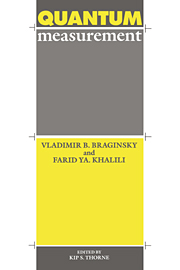Book contents
- Frontmatter
- Contents
- Dedication
- Editor's Foreword
- Notation
- Chapter I Historical introduction: photons and measurements using photons
- Chapter II The main principles of quantum mechanics
- Chapter III Indirect measurements
- Chapter IV Quantum nondemolition measurements
- Chapter V Linear measurements
- Chapter VI Continuous linear measurements
- Chapter VII Nonlinear systems for continuous measurements
- Chapter VIII Detection of classical forces
- Chapter IX Energetic quantum limitations
- Chapter X Devices for measuring small mechanical displacements
- Chapter XI Quantum nondemolition measurements of a resonator's energy
- Chapter XII Nonclassical states of electromagnetic waves as tools for quantum measurements
- Conclusion
- References
- Subject Index
Chapter XI - Quantum nondemolition measurements of a resonator's energy
Published online by Cambridge University Press: 15 December 2009
- Frontmatter
- Contents
- Dedication
- Editor's Foreword
- Notation
- Chapter I Historical introduction: photons and measurements using photons
- Chapter II The main principles of quantum mechanics
- Chapter III Indirect measurements
- Chapter IV Quantum nondemolition measurements
- Chapter V Linear measurements
- Chapter VI Continuous linear measurements
- Chapter VII Nonlinear systems for continuous measurements
- Chapter VIII Detection of classical forces
- Chapter IX Energetic quantum limitations
- Chapter X Devices for measuring small mechanical displacements
- Chapter XI Quantum nondemolition measurements of a resonator's energy
- Chapter XII Nonclassical states of electromagnetic waves as tools for quantum measurements
- Conclusion
- References
- Subject Index
Summary
Review of methods of measurement
There are two different variants of the task of measuring electromagnetic energy: i) measuring the energy in a mode of an electromagnetic resonator, and ii) measuring the energy of a traveling electromagnetic wave. This chapter deals with the first variant; the next chapter, with the second.
The general principles underlying QND measurements of energy were formulated in chapter IV. Let us recall that the main principles are: i) the response of the measuring device must be directly proportional to the energy (and not, for example, to the strength of the electric field or the charge on the capacitor); and ii) the response must contain no information about the phase of the electromagnetic oscillations. Chapter IV analyzed the simplest example of such a device: a ponderomotive sensor that registers the electromagnetic pressure on the resonator's wall.
The weakness of the electromagnetic pressure produced by a small number of quanta makes it unlikely that this ponderomotive method can be realized in practice. Because of this, several other schemes for QND energy measurements have been proposed. Most are based on nonlinear effects in dielectrics. Their practical realization is a rather complicated task because, when the energy density is low, the nonlinear effects hardly work at all, and the response of the measuring device is correspondingly small.
- Type
- Chapter
- Information
- Quantum Measurement , pp. 160 - 171Publisher: Cambridge University PressPrint publication year: 1992



